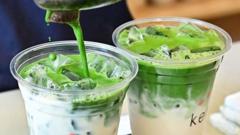In recent months, matcha, the vibrant green powdered tea hailing from Japan, has taken the world by storm. From spawning lattes at Starbucks in the UK to being a key ingredient in Krispy Kreme doughnuts in Singapore, matcha is no longer just a niche beverage but a global phenomenon. Influencers on social media platforms have played a significant role in this matcha frenzy, with hashtags like "Matcha Tok" amassing millions of views as they share tips, reviews, and recipes featuring this unique tea.
This boom in popularity coincides with Japan's post-pandemic tourism resurgence, as a weaker yen draws international visitors keen to experience local culture and cuisine, while also boosting demand for Japanese products, notably matcha. “We’re seeing all our customers running out within days what used to last a month,” Lauren Purvis, a US-based tea importer, shared, underscoring the urgency cafes feel for their matcha supplies.
However, the surge in demand clashes with environmental challenges and trade concerns, including rising temperatures affecting tea crops and US tariffs leading to inflated prices. Matcha is traditionally made from tencha leaves, which undergo an intricate process requiring shade and careful handling to develop the signature umami flavor, something that record heatwaves have threatened in regions like Kyoto – where much of Japan's tencha is cultivated.
As a result, many establishments are limiting purchases to manage dwindling stocks. Shops in Uji, a city renowned for its matcha, often find their products selling out within moments of opening their doors. The increase in demand has also led to a 30% hike in tea prices at Chazen, a tea ceremony chain, as they navigate challenges in securing adequate supply.
Despite the hurdles, the matcha market has seen some positive indicators, such as a nearly tripling of production from 2010 to 2023, with a reported 25% rise in green tea exports last year, reflecting its sustained appeal. As advocates promote mindful consumption of this delicacy, many are calling out reselling and excessive usage practices that undermine matcha’s value and heritage. The Global Japanese Tea Association recommends using lower-grade matcha for cooking, preserving the unique qualities of the high-grade varieties for traditional ceremonies.
As trade agreements evolve, the uncertainty around tariffs looms large for matcha distributors. With complications arising from US tariffs, the future remains unpredictable for the matcha market. However, some industry leaders express optimism about eventual stabilization of prices, hypothesizing that the skyrocketing demand may temper within the next few years. Though the rush for matcha continues, the message remains that this tea should be enjoyed with respect and appreciation for its traditions and craftsmanship.
This boom in popularity coincides with Japan's post-pandemic tourism resurgence, as a weaker yen draws international visitors keen to experience local culture and cuisine, while also boosting demand for Japanese products, notably matcha. “We’re seeing all our customers running out within days what used to last a month,” Lauren Purvis, a US-based tea importer, shared, underscoring the urgency cafes feel for their matcha supplies.
However, the surge in demand clashes with environmental challenges and trade concerns, including rising temperatures affecting tea crops and US tariffs leading to inflated prices. Matcha is traditionally made from tencha leaves, which undergo an intricate process requiring shade and careful handling to develop the signature umami flavor, something that record heatwaves have threatened in regions like Kyoto – where much of Japan's tencha is cultivated.
As a result, many establishments are limiting purchases to manage dwindling stocks. Shops in Uji, a city renowned for its matcha, often find their products selling out within moments of opening their doors. The increase in demand has also led to a 30% hike in tea prices at Chazen, a tea ceremony chain, as they navigate challenges in securing adequate supply.
Despite the hurdles, the matcha market has seen some positive indicators, such as a nearly tripling of production from 2010 to 2023, with a reported 25% rise in green tea exports last year, reflecting its sustained appeal. As advocates promote mindful consumption of this delicacy, many are calling out reselling and excessive usage practices that undermine matcha’s value and heritage. The Global Japanese Tea Association recommends using lower-grade matcha for cooking, preserving the unique qualities of the high-grade varieties for traditional ceremonies.
As trade agreements evolve, the uncertainty around tariffs looms large for matcha distributors. With complications arising from US tariffs, the future remains unpredictable for the matcha market. However, some industry leaders express optimism about eventual stabilization of prices, hypothesizing that the skyrocketing demand may temper within the next few years. Though the rush for matcha continues, the message remains that this tea should be enjoyed with respect and appreciation for its traditions and craftsmanship.




















